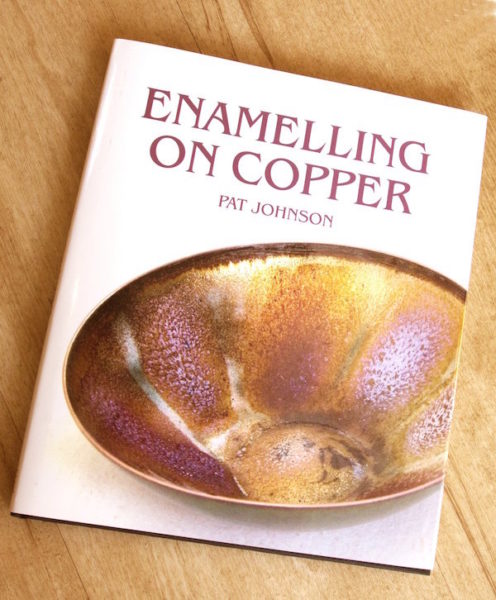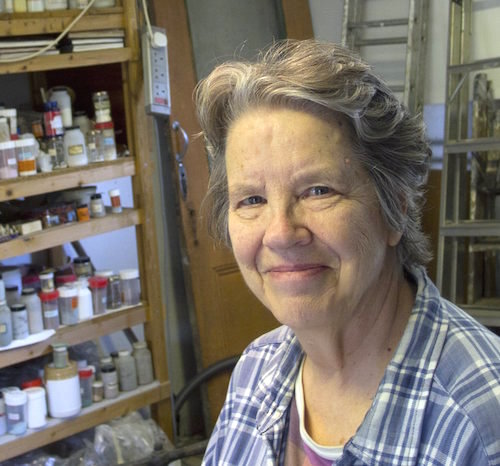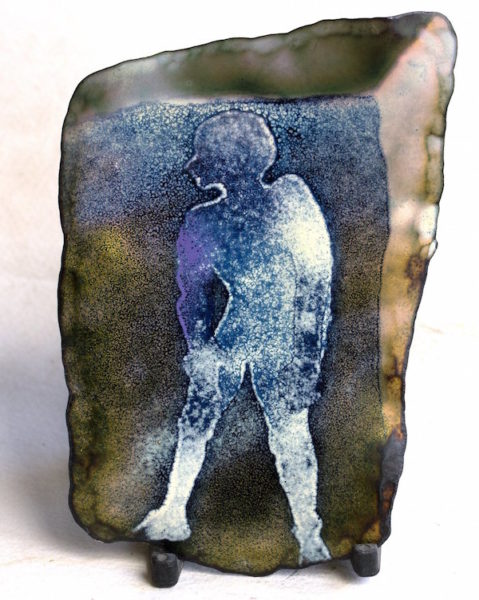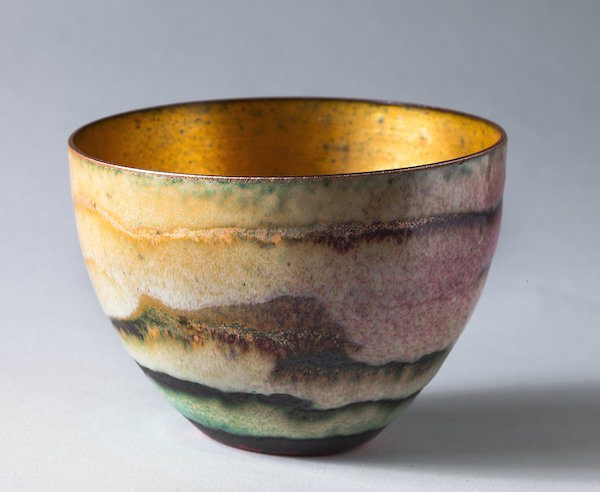 Enamelling on Copper by Pat Johnson
Enamelling on Copper by Pat Johnson
Crowood Press
reviewed by Judy Stone
The simple title, Enamelling on Copper, suggests the two most important aspects of this landmark book. Pat Johnson, who lives in the UK, has written a book that draws directly on her wealth of experience with enamel and its interactions with her chosen metal substrate, copper. Perhaps most significantly, she takes the oft-denigrated technique of sifting, or enamel layering using dry applications, and re-introduces it to young enamelists.

Johnson in her studio
Johnson is passionate about her work, and her enthusiasm radiates from the pages. Many of the paragraphs, especially those in the opening chapters, cheerlead for the experience of enameling. “First attempts at enameling are an opportunity to have an adventure . . .” But while this book was ostensibly written for beginners, it has much to offer to those who have been enameling for a long time. The sheer depth of her technical knowledge, and her detailed explanations of how enamels interact with each other and with copper, make this book a must-have for any serious enamelist.

Boy in a Rock, enamel on copper, Pat Johnson
The book starts with long and very detailed descriptions of what many may take as easy techniques, such as sifting a solid color enamel onto a flat copper surface. But Johnson uses these simple exercises to introduce some basic concepts, such as properties of the materials and metal preparation, as well as her own innovations such as wallpaper paste gum adhesive, and her application and firing methods.
In detailed examinations of more complex processes, she shares her secrets. Her vessels, examples of which are found throughout the book, have a distinctive look and feel to them, which we learn depend on several factors.
These include the high temperature (around 1650º F) with which she fires, the “controlled” looseness of her enamel applications over many firings, and the paste adhesive. (Note: Although the latter half of the book is about enameling on vessels and dimensional forms, this is not a book about metalworking for enameling; Johnson’s emphasis is on the enamel itself.)
Continually returning to the properties of enamels, their interactions with each other and with copper, Johnson slowly introduces readers to her vocabulary of insights. Many of the techniques she uses are familiar: sgraffito and stencils, incorporating copper oxide, the “bubbling up” of enamels between layers.
But her approach is unique, because she never sacrifices the ability to control what she is doing. She never gives the process over completely to chance, even as she acknowledges that total control of the medium is impossible. And while she always has composition in mind, it is composition in service of the enamels she is using.

A beautiful bowl made with lead-free enamel, Pat Johnson
Be warned–this is not a how-to book for specific techniques with specific enamels. This is partly because Johnson’s tools and materials may not correspond to what American readers are familiar with, but also because Johnson never mentions an enamel by product name or number.
In her experience, because enamel formulae often change, it is better to observe the properties rather than define an enamel by its product name and number. If she has one lesson to impart, it is that enamelists must learn as much as they can through experimentation and testing of their enamels. She wants her readers to learn how to think about enameling, and how to make discoveries for themselves.
A few minor points about the layout: For the most part, the images in the book are quite good. They highlight the methods of working she is describing in her text, and showcase her artistic talent. In some instances the images are too small to really see what she is describing, especially in some step-by-step processes.
Some readers may have problems with the book’s formatting. There are several columns per page, and the text is relatively small, which makes this a dense read, without easily readable bullet points. Many readers want their information distilled these days into digestible bits. Johnson resists this. In order to get the most from the prose, the reader must read carefully.
But the careful reader will find much to reward her. This book, like Fred Ball’s Experimental Techniques in Enameling (1973), may prove to be very influential in building new approaches to enameling. Like Ball, Johnson has dared to experiment, and has lovingly and generously shared her discoveries with us.

Recent Comments